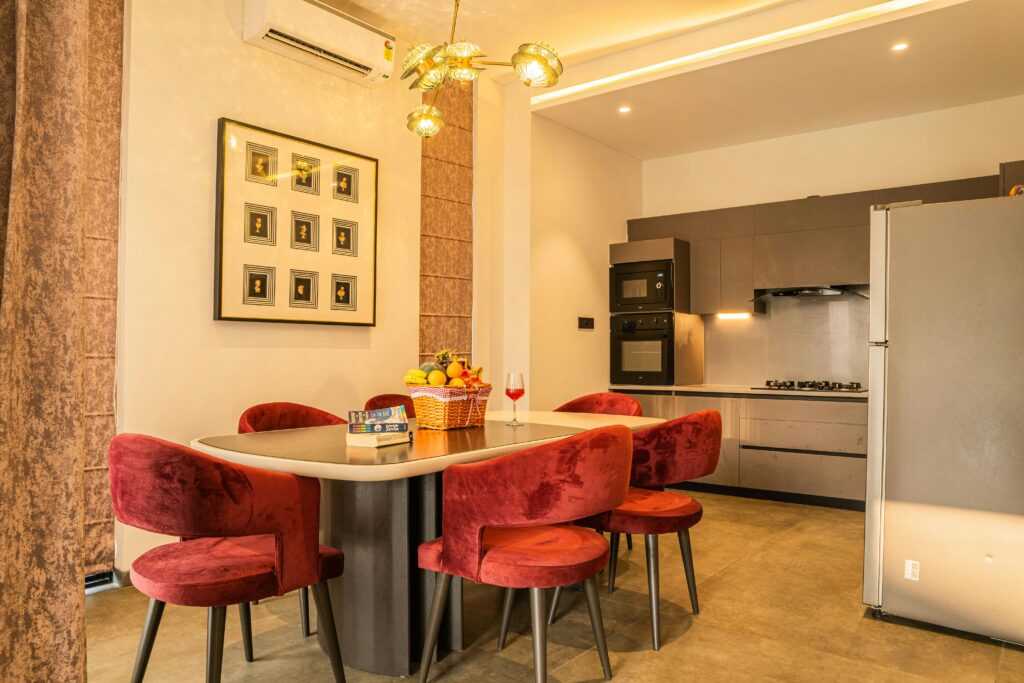You walk through your home and everything feels harmonious — until you step into the dining room. Suddenly, the atmosphere changes. Maybe the style doesn’t match the rest of the house, the furniture feels out of place, or the lighting creates a different mood altogether. A dining room that feels disconnected can make the whole home seem less cohesive, but the good news is that it’s often an easy fix. Sometimes all it takes is a fresh coat of paint, a thoughtful rearrangement, or a well-chosen new dining table to bring it all together.
The dining room should be more than just a place to eat — it’s a social hub where family and friends gather, where conversations flow, and where memories are made. When it doesn’t feel like it belongs, it’s usually because one or more design elements are clashing with the rest of your home’s style.
The Furniture Doesn’t Match the Flow
One of the most common reasons a dining room feels out of sync is mismatched furniture. If your home is decorated in a relaxed, coastal style but your dining set is formal and ornate, the room will naturally feel disjointed. This doesn’t mean everything has to be identical, but there should be a thread of consistency.
You can create harmony by echoing shapes, colours, or materials from other rooms. For example, if your living room features timber accents, choose a dining table or chairs with similar tones. If your décor is mostly modern, opt for clean lines and understated finishes.
Lighting That Doesn’t Speak the Same Language
Lighting sets the mood in any room, and if your dining room lighting feels completely different from the rest of your home, it will stand out for the wrong reasons. A single harsh ceiling light can make the space feel cold, especially if your other rooms use warmer, layered lighting.
A quick fix is to replace outdated fixtures with something that ties into your overall theme. A pendant light over the table can add personality while also creating a focal point. Adding dimmers gives you flexibility, allowing you to adjust the brightness depending on whether you’re enjoying a casual breakfast or hosting a dinner party.
Colour and Décor That Compete
Colour is one of the fastest ways to unify — or divide — a space. If your dining room walls are a bold, saturated hue that isn’t seen anywhere else in your home, it can feel isolated. Similarly, if the artwork or décor in the dining room follows a completely different style, it can jar the eye.
Bringing in shared colours from other parts of your home helps link spaces together. Even small accents, such as cushions, vases, or table runners, can be enough to tie the room in visually. Aim for at least one recurring colour or material to run through the main living areas.
Ignoring the Connection Points
The spaces between rooms matter just as much as the rooms themselves. Doorways, archways, and open-plan transitions can either connect or divide. If your dining room sits off the kitchen or living room, think about how the flooring, trim, and sight lines work together. A sudden shift in flooring material or wall treatment can be visually jarring.
Where possible, use consistent flooring across connected spaces. If that’s not feasible, consider an area rug that bridges the two styles, or repeat wall treatments like wainscoting or panelling to create a visual link.
The Room Feels Too Formal for Daily Life
Some dining rooms feel disconnected simply because they’re underused. If it’s reserved only for holidays or special occasions, it can feel like a foreign part of the home. Making the space more practical for everyday use can help it feel like a natural extension of your lifestyle.
You might repurpose a corner for homework, reading, or coffee chats. Add a sideboard or shelving for everyday items you actually use. The more you live in the space, the more it blends seamlessly into your home.
Overlooking Comfort and Practicality
A cohesive dining room isn’t just about looks — it has to feel comfortable. If the chairs are too rigid, the lighting is too bright, or the acoustics make conversation difficult, guests won’t linger. These subtle cues can make the room feel uninviting compared to other areas in your home.
Layer in textiles like rugs, cushions, or curtains to soften the acoustics. Use mixed seating for both comfort and visual interest. If the table feels cramped, consider an extendable model that adapts to your needs.
Your dining room should feel like an extension of your home, not an afterthought. By aligning furniture style, lighting, colour palette, and practical use with the rest of your living spaces, you can bridge the gap and create a room that feels connected in every sense. Even small, intentional updates can completely shift the atmosphere — making your dining room a place you’re drawn to, not just a place you pass through.


 Reginae Daviester has been a key contributor to the success of Residence Resale Tactics, leveraging her creativity and dedication to help build a platform that serves as a comprehensive resource for real estate professionals. Her role as a helper involves crafting innovative ideas and supporting content development, ensuring the platform remains engaging and valuable for its audience. Reginae’s passion for real estate is reflected in her commitment to delivering high-quality insights that empower users to navigate the market effectively.
Her diverse skill set and willingness to take on new challenges have been vital to the project’s growth, enabling Residence Resale Tactics to expand its offerings and maintain its status as a leading resource. Reginae's enthusiasm and forward-thinking approach continue to inspire the team, contributing significantly to the platform's ongoing evolution and impact in the real estate community.
Reginae Daviester has been a key contributor to the success of Residence Resale Tactics, leveraging her creativity and dedication to help build a platform that serves as a comprehensive resource for real estate professionals. Her role as a helper involves crafting innovative ideas and supporting content development, ensuring the platform remains engaging and valuable for its audience. Reginae’s passion for real estate is reflected in her commitment to delivering high-quality insights that empower users to navigate the market effectively.
Her diverse skill set and willingness to take on new challenges have been vital to the project’s growth, enabling Residence Resale Tactics to expand its offerings and maintain its status as a leading resource. Reginae's enthusiasm and forward-thinking approach continue to inspire the team, contributing significantly to the platform's ongoing evolution and impact in the real estate community.